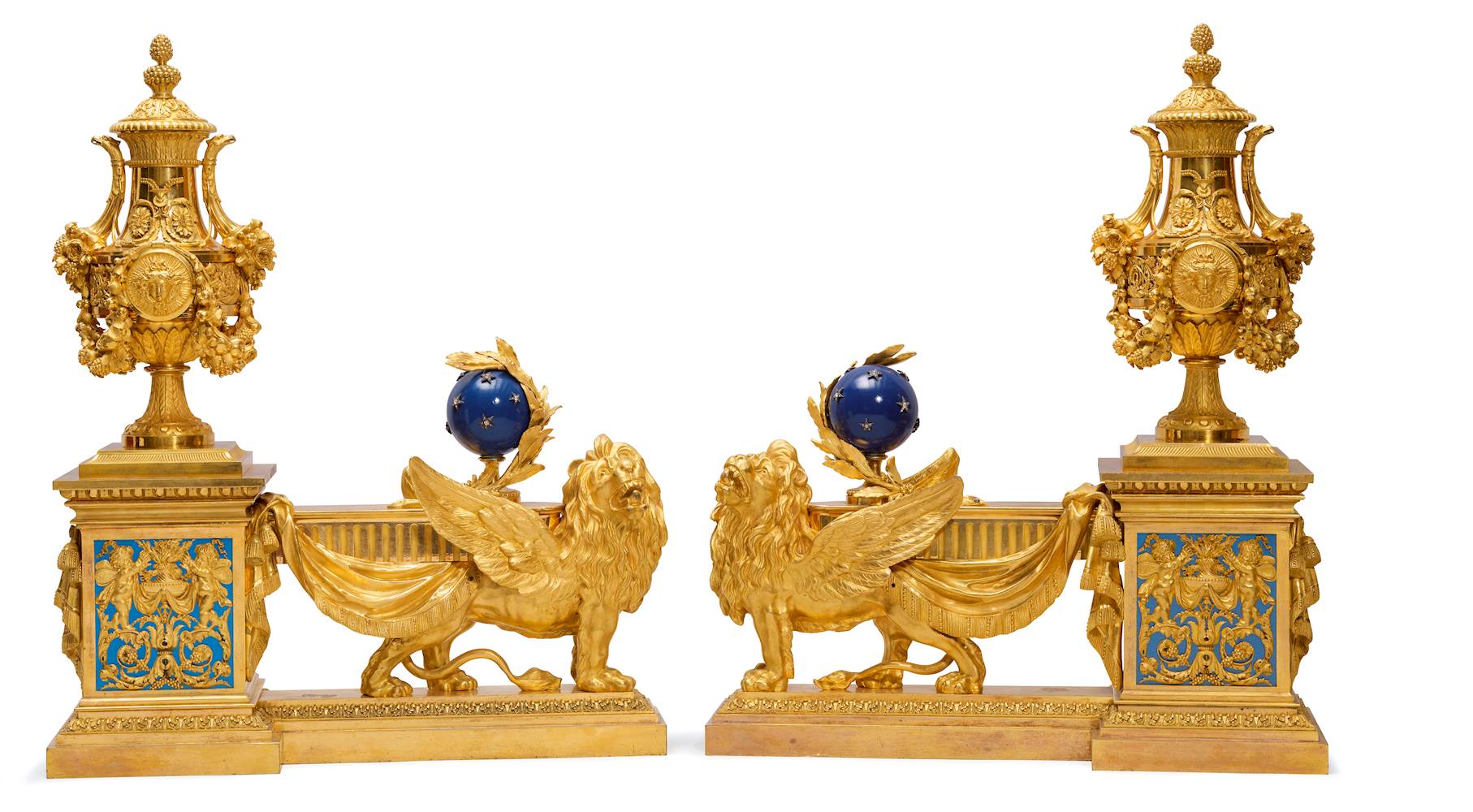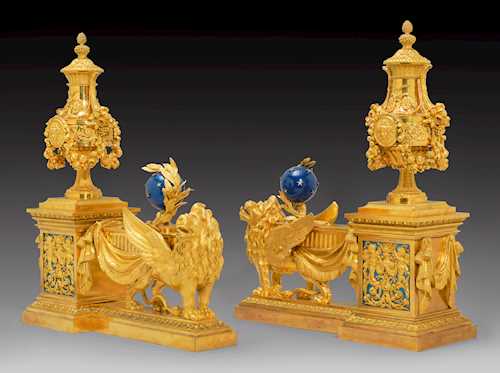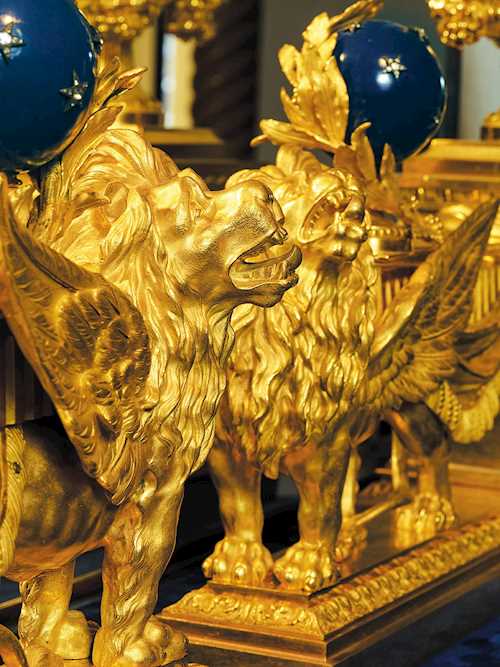
Lotto 1065* - A211 Splendore e Raffinatezza. Il Lusso Parigino del XIX Secolo - giovedì, 28. novembre 2024, 10h00
A PAIR OF OUTSTANDING FIREPLACE CHENETS “AUX LIONS AILÉS”
Louis XVI style, Paris, ca. 1860–70. Based on a model for the grand salon of Bellevue Palace, ca. 1784. Monogrammed BY (Maison Beurdeley, probably Louis-Auguste-Alfred Beurdeley, 1808–1882).
Bronze, finely worked, chiseled and punched, matte and polished gilt, and in part lacquered blue. Each in the form of an ornate lidded vase, on a square pedestal and a T-shaped plinth decorated with acanthus frieze. In the front, a blue-enameled ball, partly entwined with a laurel branch, applied with star motifs. In front, a winged lion with a mighty mane. The lidded vase is richly decorated with cornucopias ending in eagle heads, hung with flower and fruit garlands and appliquéd with sun masks. The base with two cherubs standing on arabesques, warming themselves at a casserole, against a blue background.
54.5 × 20.5 × 66 cm.
Traces of oxidation, gilding partly rubbed.
The model for these magnificent mantelpieces was ordered in quadruplicate by the two princesses Marie Adélaide (1732-1800) and Marie Louise Thérèse Victoire (1733-1799), sisters of King Louis XVI, for the Grand Salon of Bellevue Palace. This château in the vicinity of Paris near Meudon was built in the 1750s by Louis XV. The fireplace chenets were supplied in 1784 by the Darnault brothers, well-known “marchand merciers” of the time. The design and maker have not survived in the documents; an original attribution to Thomire was rejected. These two pairs from the 18th century, just like the work by Beurdeley on offer, also featured sections worked in blue. However, these were gilt over time, just as the pieces are kept today in the Louvre (inv. no. OA 5261) and Versailles (inv. no. 11277). The original “fleur de lys” ornaments on the globes mentioned in the invoice were replaced by today's star motifs at a later date.
The mantelpieces on offer were made by Louis Auguste Alfred Beurdeley (1808-1882), some of the bronze parts are marked BY. Louis Auguste Alfred came from a dynasty of ebenists who were active throughout most of the 19th century and were famous for their high-quality furniture and bronzes. Their own designs were based on models from the Ancien Régime, but in some cases, as in this case, objects from the 18th century were copied directly. The quality of Beurdeley's bronzes in particular was not inferior to that of the 18th century masterpieces and in some cases even surpassed them. This is due to the fact that, in addition to the design, also the working techniques of the 18th century were adopted (Ottomeyer/Pröschel: Vergoldete Bronzen. Munich 1986, vol. I, p. 413 ff).
The pair of fireplace chenets on offer is an excellent example in this respect. The dynasty was founded by Jean Beurdeley (1772-1853), who, after serving in the Napoleonic army, settled in Paris and ran a “magasin de curiosités” as a “marchand mercier”. In 1840, he acquired the so-called “Hanover Pavilion”, which was run by his son Louis Auguste Alfred (1808-1882). The success of the luxury furniture produced was immense and was increased by important orders from the aristocratic upper class. Alfred Emanuel Louis Beurdeley successfully continued the business as his successor. In 1878, he was awarded the gold medal at the Exposition Universelle in Paris. He also opened a gallery in New York to satisfy the great demand for luxury furniture in the United States. In 1883 he was awarded the “Ordre National de la Légion d'Honneur”.
Literature:
- Daniel Alcouffe et al: Gilt bronzes in the Louvre. Dijon 2004, pp. 196-199, No. 100.
- Ottomeyer/Pröschel: Gilt Bronzes. Munich 1986, vol. I, p. 273, fig. 4.11.6.
- Pierre Verlet: Les Bronzes dorés français du XVIIIe siècle. Paris 1999, p. 368, No. 379.
The model for these magnificent mantelpieces was ordered in quadruplicate by the two princesses Marie Adélaide (1732-1800) and Marie Louise Thérèse Victoire (1733-1799), sisters of King Louis XVI, for the Grand Salon of Bellevue Palace. This château in the vicinity of Paris near Meudon was built in the 1750s by Louis XV. The fireplace chenets were supplied in 1784 by the Darnault brothers, well-known “marchand merciers” of the time. The design and maker have not survived in the documents; an original attribution to Thomire was rejected. These two pairs from the 18th century, just like the work by Beurdeley on offer, also featured sections worked in blue. However, these were gilt over time, just as the pieces are kept today in the Louvre (inv. no. OA 5261) and Versailles (inv. no. 11277). The original “fleur de lys” ornaments on the globes mentioned in the invoice were replaced by today's star motifs at a later date.
The mantelpieces on offer were made by Louis Auguste Alfred Beurdeley (1808-1882), some of the bronze parts are marked BY. Louis Auguste Alfred came from a dynasty of ebenists who were active throughout most of the 19th century and were famous for their high-quality furniture and bronzes. Their own designs were based on models from the Ancien Régime, but in some cases, as in this case, objects from the 18th century were copied directly. The quality of Beurdeley's bronzes in particular was not inferior to that of the 18th century masterpieces and in some cases even surpassed them. This is due to the fact that, in addition to the design, also the working techniques of the 18th century were adopted (Ottomeyer/Pröschel: Vergoldete Bronzen. Munich 1986, vol. I, p. 413 ff).
The pair of fireplace chenets on offer is an excellent example in this respect. The dynasty was founded by Jean Beurdeley (1772-1853), who, after serving in the Napoleonic army, settled in Paris and ran a “magasin de curiosités” as a “marchand mercier”. In 1840, he acquired the so-called “Hanover Pavilion”, which was run by his son Louis Auguste Alfred (1808-1882). The success of the luxury furniture produced was immense and was increased by important orders from the aristocratic upper class. Alfred Emanuel Louis Beurdeley successfully continued the business as his successor. In 1878, he was awarded the gold medal at the Exposition Universelle in Paris. He also opened a gallery in New York to satisfy the great demand for luxury furniture in the United States. In 1883 he was awarded the “Ordre National de la Légion d'Honneur”.
Literature:
- Daniel Alcouffe et al: Gilt bronzes in the Louvre. Dijon 2004, pp. 196-199, No. 100.
- Ottomeyer/Pröschel: Gilt Bronzes. Munich 1986, vol. I, p. 273, fig. 4.11.6.
- Pierre Verlet: Les Bronzes dorés français du XVIIIe siècle. Paris 1999, p. 368, No. 379.
CHF 90 000 / 120 000 | (€ 92 780 / 123 710)









